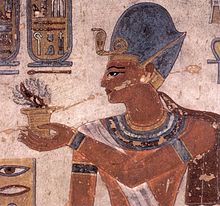Water gardens
A water garden is a garden in which the chief thing, interest, and attraction is water and plants that live in water. The water may be put in a fountain, a pond, a waterfall, or other. Water have been built for thousands of years. It was natural that in the hot places of Egypt and Mesopotamia refreshing water gardens should be found. As early as 1225 BC, Ramses III built water lily ponds.

The Inca of Peru built gold and silver water channels, pools, and basins as early as 2500 BC. Their homes and palaces had water running in channels under the floors to cool the surrounding air. Their courtyards had cooling pools for tired travelers.
The Chinese and Japanese imitated nature in their water gardens. The water garden was a sign of perfection and peace. By the third century AD they had written down the essentials of a water garden. In the 15th century, they turned the water garden into an art form that used the sound and motion of water. A reflecting pool expressed the union of heaven and earth. The Japanese built a dry garden, using small rocks, sand, and other materials to represent the course of a stream or river. Nature was recreated to serve as a source of thinking.
Europeans began using water for playing in the Middle Ages. Springs and wells were made focal points in gardens. Carp pools not only provided food, but a place for thinking and resting in monasteries. In Spain, the starkness of the Alhambra was softened with canals and pools.
Related pages
changeGallery
change-
Lion Fountain at the Alhambra
-
Baths of Apollo at Versailles
-
Japanese water garden
-
Kew Gardens, London
-
Renaissance garden at Villa Lante, Italy
-
Yuyuan water garden in China
-
Papyrus in an Egyptian water garden
-
Peterhof cascade
References
change- Paul, Anthony; Rees, Yvonne (1986), The Water Garden, Penguin Books, pp. 8–10, ISBN 0-14-046756-4